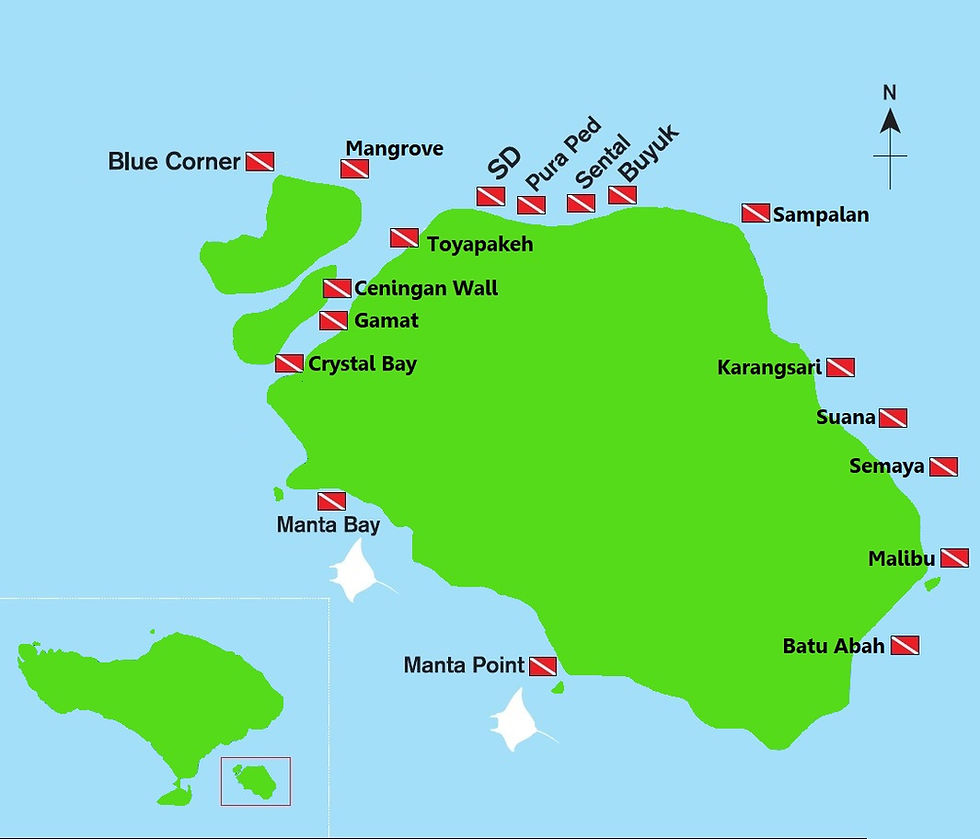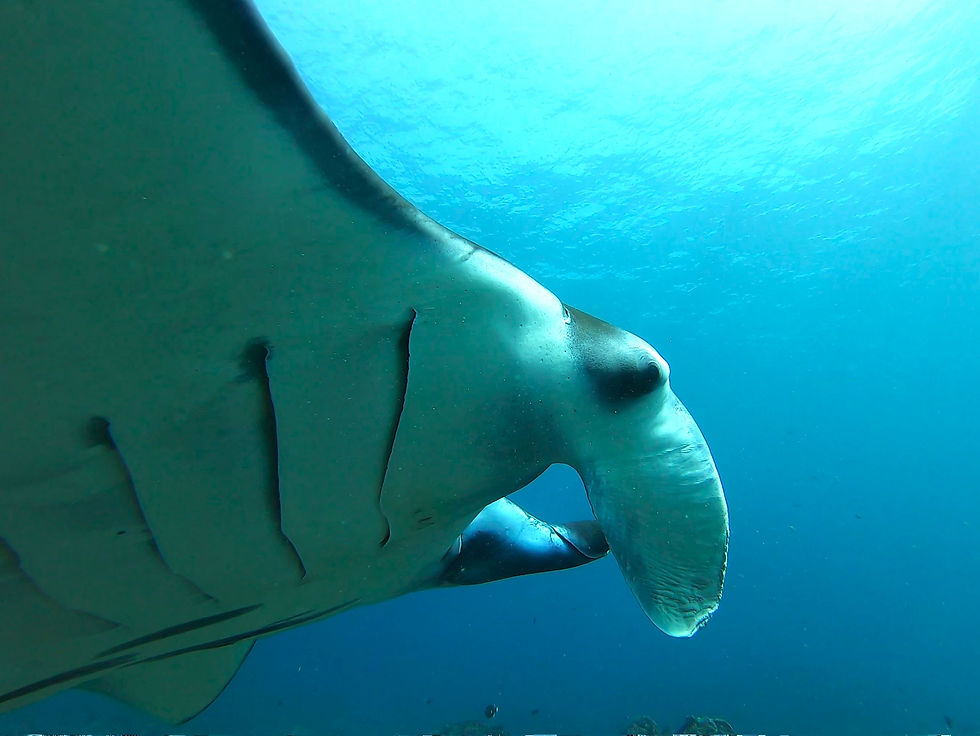Manta Rays Special!
- Divingscene

- Jul 9, 2022
- 5 min read
Updated: Aug 16, 2022
Gooooood morning divers!

I wanted to make this blog a "Manta Special" since a lot of divers come to Nusa Penida and Lembongan to go diving at Manta point or Manta bay. I have been blessed to go dive here 3 times now, and with all the photos and films I've made I thought it could be a nice change from the regular diving/ travel blog.
I have been diving Nusa Penida now for a week with Roctopus dive Lembongan and have been having a blast! This is a very professional diving center run by devoted divers and perhaps the best-maintained gear I've seen so far.
Why is Manta point so famous?
What's so special about Manta ray?
What should you do and not do when you encounter a Manta ray?
An impression of the diving scene.
Where else do you have a good chance of spotting manta?
What's next?
Why is Manta point so famous?
The obvious, and true answer would be: Because you can see manta rays. This in itself is a good reason for hundreds of divers to travel to Nusa Penida/ Lembongan every year.
Although there are quite a few places you can dive with a manta ray, this one is especially famous because of its proximity to Bali and the many tourists it attracts. You can stay in Nusa Penida, Lembongan or Ceningan. However, you can also arrange diving trips from Sanur for example in "Mainland" Bali.
The dive site is situated on the south side of Nusa Penida as shown on the map below.

The topography of this area is simply amazing! The waves crashing into to rugged coastline, creating dramatic bursts of water, high into the air. Massive waves welcome you, adding to the excitement! Once around the corner, there is a more quiet spot, and here you'll find the dive site.


What's so special about Manta ray?
There are 2 main species of manta ray: The reef Manta and the Oceanic Manta.
Only since 2017 has the distinction been made between the reef manta and oceanic manta!
The reef manta is a lot smaller than the oceanic manta, but still very impressive. Manta ray can have a wingspan of 30 feet (9 meters)! Usually, you will encounter smaller ones between 6-15 feet (2-5 meters) but there's always that chance you will see the "big one"!
Oceanic Manta rays usually stay in deeper waters, but come up once in a while, to visit the cleaning stations in more shallow waters. Cleaner fish reside here and eat the parasites, algae, and other unwanted things of the manta ray and fish.
Manta rays are very intelligent cold-blooded fish, on par with dolphins, mantis shrimps, and others. They can actually recognize themselves in a mirror and are highly social.
The oceanic manta has one of the largest brains, weighing up to 200 g, (five to ten times larger than a whale shark brain) and the largest brain-to-mass ratio of any fish. It heats the blood going to its brain and is one of the few animals (land or sea) that might pass the mirror test, seemingly exhibiting self-awareness (Wikipedia).
Manta rays don't have many enemies, just because of their sheer size alone. They will occasionally be attacked by large sharks or killer whales. They can, however, escape very frequently because of their very high swimming speed. They can accelerate to 24km/hour with ease!
Some people might also witness manta rays jumping from the water. This can have 2 reasons: To impress a female or to get rid of parasites. Either way, an impressive feat nonetheless!

What should you do, and not do when you encounter a Manta ray?
Like I said before, Manta rays are highly social and intelligent creatures. They're also very curious and inquisitive.
You often find them hovering in place, in the current, while being serviced by the cleaning crew and you can actually get quite close to them. Or just watch them from a distance and admire their size and gracefulness.
When encountering a Manta ray, they will usually be interested in finding out what you are. They will swim up to you and turn just before coming too close. However, if you control your breathing, and blow small bubbles (DON'T hold your breath) they might even "fly" right over you.
Because Manta rays are social, they are always looking to find their specie, and sometimes it pays off to flap your arms slowly up and down. while remaining calm, in neutral buoyancy. They tend to be interested in finding out what you are before realizing, you're just an imposter.
Manta rays can come up REALLY close to you, and whatever you do, never touch them, even though it might be tempting. They could flee and be scared or even get sick!
So to summarize:
Never touch a manta ray.
Don't be afraid of their size. They have never even harmed a human being and they can't sting you like other rays.
Let them come to you. They are gentle and curious, and much, much faster than you.
Blow small bubbles to not scare them away.
Mimicking flapping the wings can lure them to you. (if it fails, you'll have fun seeing other divers try it too).
Don't forget to look up to the surface, they might be above you.

An impression of the diving scene.
Nusa Penida as a diving scene is actually made up of 3 islands: Penida, Ceningan, and Lembongan.
Manta Point and less frequently visited Manta Bay are both on the south side of the island as shown before on the map. The topography is simply stunning. Just the boat ride to the dive site is worth the trip!

Manta point is a very easy dive site suitable for all levels of divers. The average depth is about 12 meters, however, you could swim away from the cleaning stations a bit to reach a nice swim-through at 22 meters. Most dives will, however, be focused on the cleaning stations.
There is usually a swell because you will be relatively close to the coastline, but nothing to worry about.


Where else do you have a good chance of spotting a Manta ray?
You can find Manta rays in tropical waters around the world. They prefer temperatures of 20 degrees and up and can be spotted close to the surface from spring-fall depending on the temperature along coastlines. In colder months they will swim more off the coast so spotting them is less likely.
During the day they tend to swim in more shallow waters and at night they can go down to depths of 1000 meters! The reef manta stays along the coastline usually and won't travel as far off the coast.
A few good spots to go diving are:
What's next?
The next blog will be from The Philippines! I have visited this beautiful country in 2018, and now it's time to go back and explore all the places I haven't visited the last time.
This will hopefully complete the full Philippines experience and make for amazing stories, photos, and travel tips!
Thank you for taking the time to read this, any questions or tips can be sent to contactdivingscene@gmail.com, and remember:
"If you can breathe, you can dive"

Want to visit Nusa Lembongan yourself? Book your stay and/or travel guide here!
Don't forget to check out the clips I've made below!








Comments